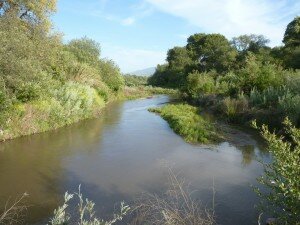watershed function

Photo by Steve Shimek
Rich functioning watersheds not only provide vital habitat for plants and wildlife, but also provide a critical water quality function filtering out pathogens, sequestering chemicals, and ‘using’ nutrients. Pollution engineers actually call plants “vegetative treatment systems!” This treatment function is especially critical in cities and around farms; the river or creek’s riparian corridor becomes the only opportunity to stop chemicals and pathogens from contaminating open water and groundwater.
For generations farmers have lived and worked on the banks of a sometimes tumultuous creeks and rivers. In fact, periodic flooding is what gives most agricultural lands their richness. But today, the organic material and minerals (soil amendments) can be chemically added. Occasional flooding has become a liability instead of a benefit. Along some areas of the Central Coast our rivers are being bulldozed and channelized.
Protecting river flow is critically important. Thousands of species of plants and animals are supported by healthy river systems and without adequate flows, the rivers along with these species literally dry up and die. River flow is also important to sea otters: The Otter Project believes sea otters will thrive in a clean and healthy environment. Pollutants are treated by healthy riparian and river systems.
In cities, gutters and storm drains were the norm until recently when we realized the benefits of Low Impact Development (LID). LID practices infiltrate the water into vegetation and soils for treatment instead of fast-tracking pollution to rivers and the ocean.
Naturally treating the water keeps the pollution from ever reaching the ocean and our otters. As water becomes more valuable, strategies to infiltrate and treat the water and store it in the aquifer for reuse will become the new paradigm.
In June of 2016 The Otter Project filed a “Sixty-Day Notice of Intent to Sue for Endangered Species Act and Clean Water Act Violations in Relation to the Salinas Valley Water Project” to NOAA Fisheries, Army Corps of Engineers, and Monterey County Water Resources Agency (MCWRA). A “60-Day Notice of Intent” is generally sent to agencies so that they have the opportunity to take corrective action before a lawsuit is filed. Click here to go to the the 60-Day Notice project page.
 Our water quality program is affiliated with the international Waterkeeper Alliance and is separately branded as Monterey Coastkeeper. Waterkeepers around the world are dedicated to protecting and restoring clean — drinkable, swimmable, and fishable — waters. The Alliance is led by Bobby Kennedy Jr.
Our water quality program is affiliated with the international Waterkeeper Alliance and is separately branded as Monterey Coastkeeper. Waterkeepers around the world are dedicated to protecting and restoring clean — drinkable, swimmable, and fishable — waters. The Alliance is led by Bobby Kennedy Jr.
Facebook Wordpress Twitteryoutubemeet